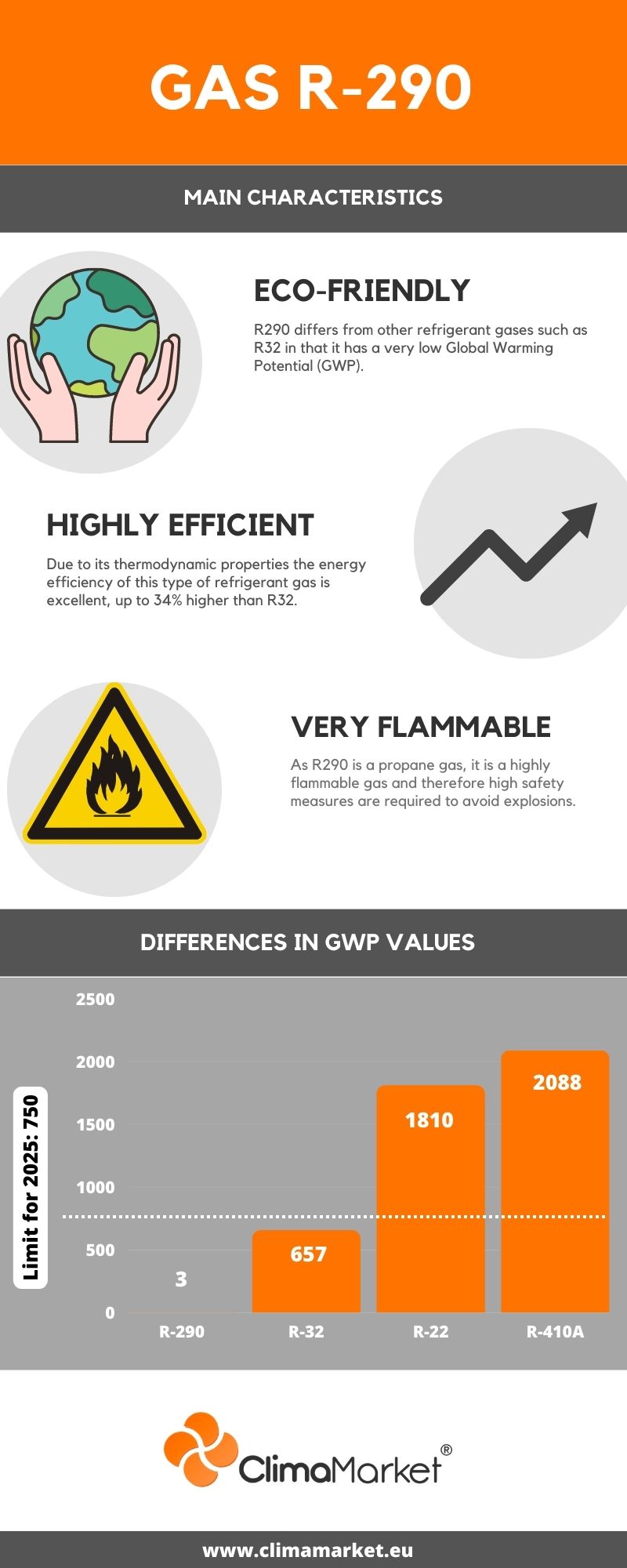R290 refrigerant gas. What is it and what are its advantages?
2 May 2023 / Cassette Air Conditioners
Sustainability and environmental care are becoming increasingly important in all aspects of our lives, and the refrigeration industry is no exception. In this context, refrigerant gases have become a concern for the industry due to their impact on the environment and climate change. The refrigerant gas R290, also known as propane, is presented as a more sustainable and environmentally friendly alternative to other refrigerant gases. In this blog, we’ll tell you everything you need to know about R290 gas, its advantages and disadvantages, and how it is currently being used in the refrigeration industry. Read on to find out more about this sustainable and efficient alternative!
What is R290 refrigerant gas?
R290 is a type of natural refrigerant gas also known as propane. It is a pure hydrocarbon that is in a gaseous state at ambient temperature and pressure. Due to its favourable thermodynamic properties, R290 is used as a refrigerant in refrigeration and air conditioning systems instead of the more common synthetic refrigerant gases such as R22 or R410A.
In addition, R290 is a very environmentally friendly refrigerant gas, as its impact on global warming is very low due to the fact that as a pure gas it does not contain chemical agents that emit greenhouse gases into the atmosphere. In addition, it is a very energy efficient gas, making it a viable and sustainable alternative to synthetic refrigerant gases.
Refrigeration technologies using R290 can be adapted to both commercial and industrial systems and equipment. However, in Europe, there are regulations that regulate refrigerant charge limits depending on the application and installation location. In summary, R290 is an efficient natural refrigerant with low environmental impact, but it is important to handle it with care due to its flammability.
What is the difference between R32 and R290 refrigerant gas?
Earlier in this blog we discussed the differences between the refrigerant gases R32, R410 and R22. As we saw, R32 is the most modern and efficient refrigerant gas due to its advantages over other gases, so what is the difference between R32 and R290?
The main benefit of R290 refrigerant gas is that it is a much more efficient and environmentally friendly type of gas as it has a lower Global Warming Potential (GWP) index than other gases such as R32. Specifically, the GWP usage of R290 refrigerant gas is 3 while R32 has a GWP index of 657.
Moreover, as it comes from fossil fuels, it is a pure gas that does not need to be combined with other chemical compounds as is the case with other refrigerant gases. This purity extends the life of the aerothermal units by avoiding problems related to the deterioration of the mechanisms and compressor breakage.
However, unlike R32, R290 is propane gas and these gases have the problem that they are highly flammable and explosive, and therefore equipment with a certain refrigerant charge requires many safety measures. Currently R290 gas is used in aerothermal equipment for commercial use. However, due to the benefits we have seen it seems that little by little the manufacturers are going to bet more and more on this type of refrigerant gas.
Advantages and disadvantages
Advantages:
- Low global warming potential (GWP) of , making it a more sustainable and environmentally friendly option compared to other refrigerant gases.
- Excellent energy efficiency, as it requires less energy to reach and maintain the desired temperature.
- Contains no chlorine or fluorine, making it less harmful to the ozone layer.
- No damages due to its high purity.
- Compatibility with existing equipment.
Disadvantages:
- Flammable and may present certain hazards if handled incorrectly or in leak or fire situations.
- Requires additional safety measures such as ventilation and fire suppression systems.
- May have limited market availability compared to other refrigerant gases.
- May require modifications to existing equipment for use.

Comparison between R32 and R290
To clarify the differences between the refrigerant gas R32 and R290, here is a comparative table showing the differences between these two gases:
| Characteristics | R32 | R290 |
|---|---|---|
| Global Warming Potential (GWP) | 675 | 3 |
| Chemical composition | Difluoromethane (R-32) | Propane (R-290) |
| Flammability | Low | High |
| Flammability limits (% by volume) | 13.4-32.0 | 1.8-9.5 |
| Vapour pressure at 25°C (kPa) | 551.2 | 853.9 |
| Density at 25°C (kg/m3) | 958.2 | 516.1 |
| Molecular weight (g/mol) | 52.02 | 44.09 |
| Evaporating temperature (°C) | -51.7 | -42.1 |
| Condensing temperature (°C) | 55.0 | 36.7 |
| Explosion hazard | Low | Low |
| Toxicity | Low | Low |
| Energy efficiency | Good | Excellent |
| Compatibility with existing equipment | Good | May require modifications |
| Market availability | Wide | Limited (for commercial use) |






Priyansh Shelke
16 October, 2023
Thanks for the informative blog I found your blog. Blog very informative keep posting.